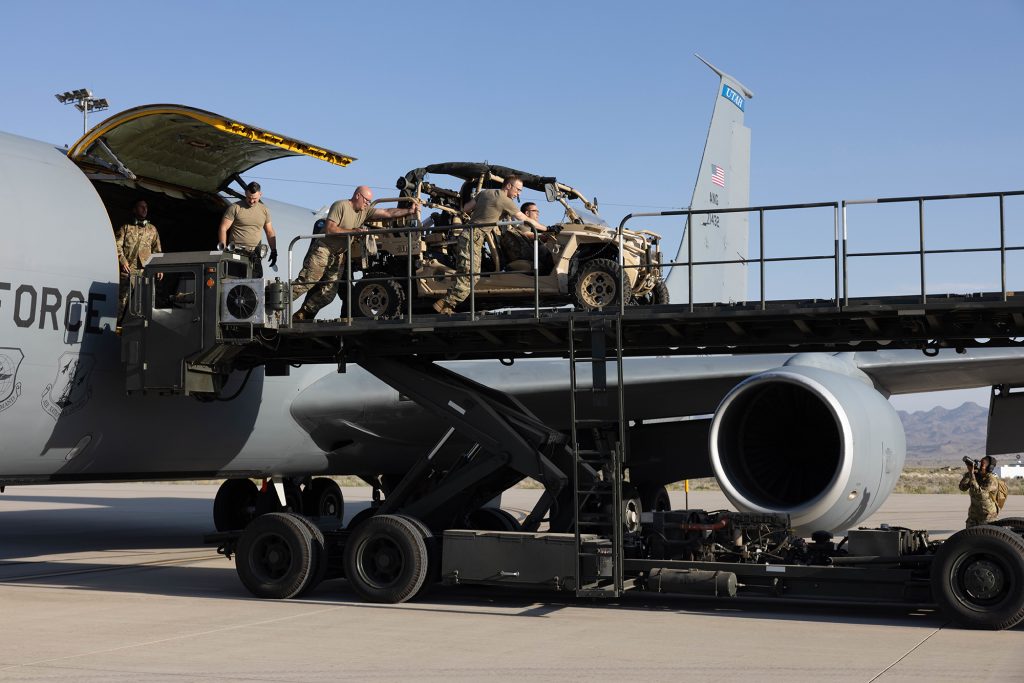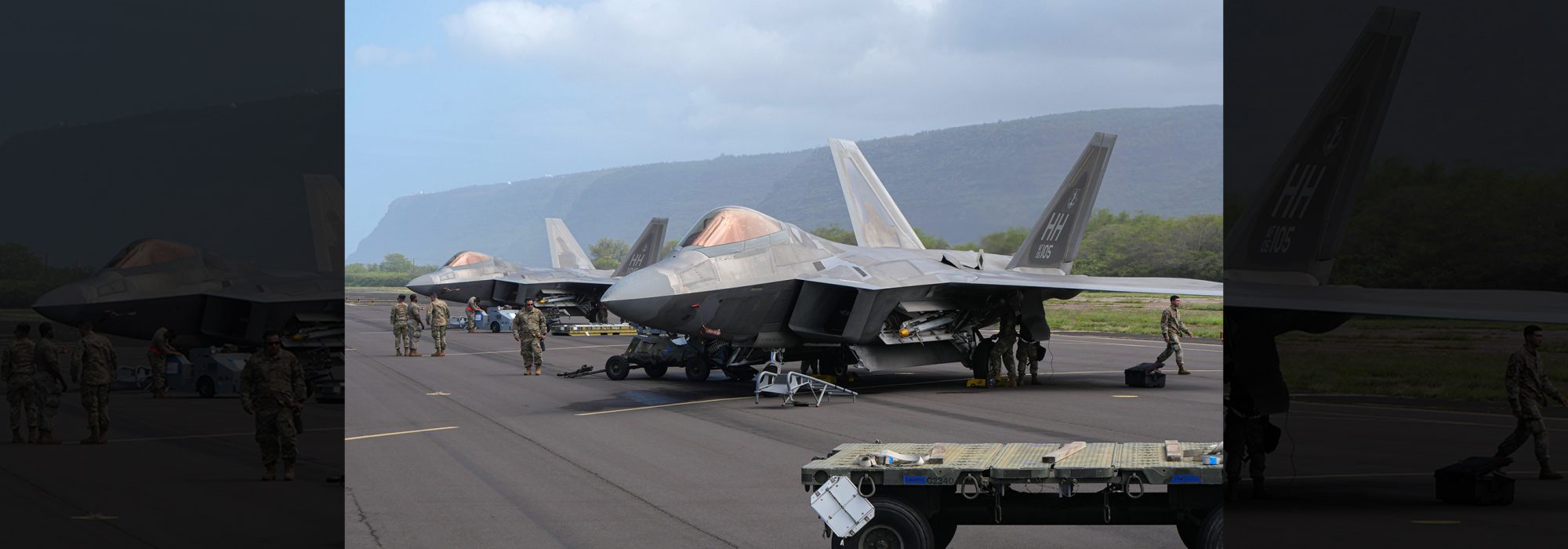Readiness to Deploy and Fight
The COVID-19 pandemic and Russia’s invasion of Ukraine exposed weaknesses in the industrial base and supply chains the U.S. military depends on for spare parts, munitions, and other key services and supplies. For the Air Force, those revelations exacerbate anticipated shortfalls in airlift and aerial refueling capacity to meet the requirements of wartime scenarios with a peer adversary in the Indo-Pacific region.
Regardless of what happens in the opening salvos of any fight, the question that weighs most heavily is logistics: Can the Air Force sustain far-flung front-line forces to win the fight?
CHALLENGE: Analyze the mobilization and support chain to ensure the entire system is hardened against all threats an enemy might present so the Department of the Air Force can meet its commitments to combatant commanders.


APPROACH: Identify gaps and vulnerabilities in the department’s ability to transition to and support current and projected operational plans in a contested environment and prioritize solutions.
“The severe challenges we face today with readiness would be even more pronounced in a conflict, so we need new approaches to enhance resilience and facilitate fighting under attack in a conflict,” said Timothy Walton, a senior fellow at the Hudson Institute, in an interview.
Among those challenges are shortfalls in weapons production, gaps in refueling, storage, and prepositioning capacity, potential vulnerabilities to cyberattacks, as well as training, materiel readiness, and operational complacency and flexibility.
“We’re coming off a couple of decades of conflict in which all of our comms were essentially secured, we were not competing with a peer, and I think most of us in the room believe the next conflict will be quite different from that,” said Brian Morrison, vice president and general manager of cyber systems at General Dynamics, at the AFA Warfare Symposium in March.
Strengthening the defense industrial base, diversifying supply chains, and fortifying information networks are ambitious and required—but there is no silver bullet.
“Many of the other operational imperatives identify systems of systems or warfighting areas,” Walton said. “This one is a bit broader. … The rub is that it is unlikely to be any single system or class of systems that will be the solution.”
Transitioning to a wartime posture involves building new infrastructure around the world, modernizing aircraft, and a combined and joint approach to warfighting that involves close coordination with allies and the other U.S. military branches. Over time, it will require more investment to develop additional airlift and refueling platforms—and new authorities and systems to deploy war-
fighters more rapidly.
“You have to ultimately convince a variety of stakeholders, at both the Department of Defense level and ultimately Congress, that what you’re asking for is needed, that it is the right investment,” said Dahlia Goldfeld, a senior information scientist at the RAND Corporation, in an interview. “That’s hard because there are a variety of competing factors. What a certain congressman wants may not be what the Airmen within the logistics directorate think is the most important thing.”
Yet Congress does appear to be listening. The House Armed Services Subcommittee on Seapower and Projection Forces engaged on the matter of recapitalizing the Air Force’s aging KC-135 tankers, directing the Air Force in its markup of the 2024 National Defense Authorization bill to prepare a business-case analysis, along with Joint Staff-validated requirements, for a replacement tanker. It also asked for options to fulfill the Next-Generation Air Refueling System requirement, a longer-term need, before the KC-135 recapitalization strategy is completed.
Such language, Walton said, shows “keen congressional interest in identifying solutions for contested logistics, next-generation tankers, and next-generation mobility aircraft.”
Longer-term, the Air Force is investigating new concepts like rocket-delivered cargo, pre-positioned stocks of fuel and ammunition, and even mobile jet fuel factories that could reduce dependence on long, vulnerable fuel supply lines. Though some of these capabilities may be a long way off, their development is part of the branch’s renewed focus on reducing vulnerabilities and strengthening resilience in its logistics, Walton said. While some of these capabilities are still conceptual, he added, the fact that they are getting attention shows the seriousness with which the Air Force is addressing vulnerabilities.
Likewise, the Air Force wants to shift away from a top-down, hierarchical command and control structure to a more distributed structure where units are encouraged to take greater initiative if isolated from higher commanders.
“I think part of this is a shift in mindset,” Walton said. “We want to encourage air and space units to generate promising courses of action and execute them on their own initiatives, even if they lose communications.”
Case in point: During Exercise Resolute Sentinel in South America, Airmen were tasked to rapidly relocate and operate from austere bases, exercising the Agile Combat Employment concept of operations. Airmen set up a forward area refueling point (FARP) on July 12, gassing up an A-10 from an HC-130 in a remote airfield. But first they had to overcome a supply problem: “The A-10s need additives for their fuel,” spokesman Lt. Col. Mickey Kirschenbaum told Air & Space Forces Magazine. “We thought we had a contractor here that was going to provide that, and they weren’t able to. So we had to come up with a solution to ferry fuel from one location to the other and then put the additives in so the A-10s can fly. … We’ve been doing a lot of events like that, overcoming obstacles that you would see in a deployed location.”
Airmen in that and other exercises have also emulated operations in which communications were jammed or disabled. Such threats make information security among the most crucial aspects of fortifying supply networks, both the physical infrastructure and the software and communications they depend on. Achieving real information security requires understanding and buy-in from everyone in the warfighting enterprise.
“Most of the penetrations we’ve had have not been unbelievably sophisticated attacks, they’ve been known exploits or exploits of known vulnerabilities that we had the means and the knowledge to remediate,” Morrison said. “The first thing we all have to think about, all the time, is: Are we doing what I would call cyber hygiene?”
Are proper procedures being followed, are all the defenses up, or are guardrails disabled for people’s convenience? “I assure you that those two or three peer adversaries are working every day to break our codes, to get inside our sensors, to read our communications, to hear what we’re saying to each other,” he said.

That’s now, before a conflict is underway. The intensity of those probes and challenges will only increase over time. The only way to stay ahead is to move faster, iterate better and more agile solutions rapidly, to gain ground on a persistent foe. He cited the rapid development of Mine-Resistant Ambush Protected vehicles during the wars in Iraq and Afghanistan as an example of cutting through the usual bureaucracy to rush capability to warfighters in desperate need for better protection 15 years ago.
“There was no question about, ‘How am I going to get paid for this? Are the requirements lying flat? Do we have all the contract terms?’ It was urgency to mission, and then we’ll let everything else sort out along the way,” Morrison said. “Everybody’s got lawyers, everybody’s got contracts. We’ve got to worry about them. But I would love for all of us together to get back to that moment of urgency, because I think we are [already] in a hot war.”
